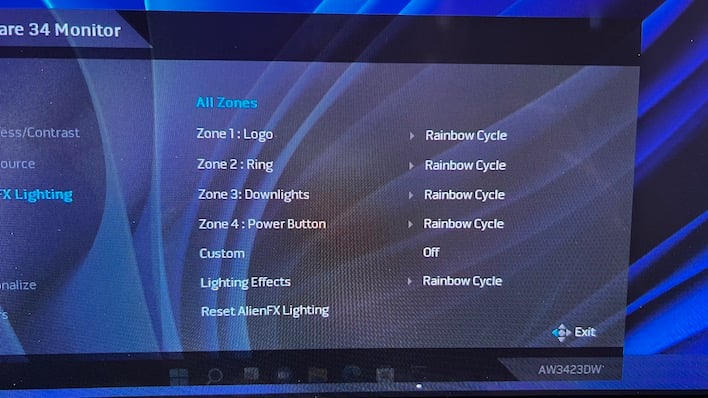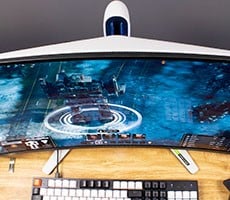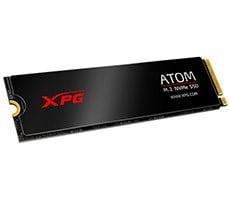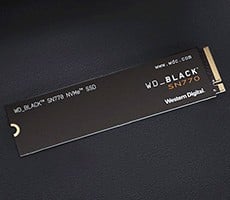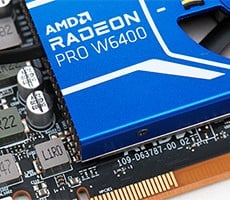Alienware AW3423DW QD-OLED Review: OSD, Color Testing, Image retention
Obviously there are plenty of other options, like changing inputs. There's also a black stabilizer function that counterintuitively actually increases the brightness of certain dark levels, rather than compressing them down to black. We left that option alone since we were able to calibrate the monitor without it. There's also a volume setting that didn't quite work as expected. Even though there are separate jacks for headphones and line level output, there's only one volume and it controls both. Our recommendation is to set this based on how you like your headphones, if you're going to use it at all, and then adjust speakers to compensate via the line output.
There are plenty of other options buried in this menu as well. The other area where you might spend a decent amount of time is the Lighting options menu. There are a total of four RGB LED zones on the AW3423DW: the rear light ring, the Alienware logo, downward-facing LEDs next to the joystick, and the power button. All four are set by default to a rainbow wave with colors that chase through one another. There's also a Comet setting, which picks a solid color and sticks to it, and a Spectrum option that cycles through different colors in unison rather than chasing. They're basic, and they can be disabled entirely, but they're here and it can be fun to play around with them.
Something interesting that could have been added to these color options is display-matched back-bias lighting, where the lighting color dynamically changes based on what is being displayed on-screen. This sort of thing appears on TVs from time to time, where different zones light up colors based on what's at the edge of the screen, and that kind of lighting can add to the immersion. Of course, nothing like this is mandatory, but the lighting is already present, and that ring around the stand mount could potentially have been used to great effect. As it is, it's just a small missed opportunity.
Alienware AW3423DW Calibration and Color Accuracy
Time to dive in and test this QD-OLED monitor out. To get a feel for the image quality of the AW3423DW, we turned to our trusty colorimeter and DisplayCAL 3, just like we did with the Gigabyte Aorus CV27F. Our goal is to get the display calibrated and then test the color gamut and brightness claims, as well as check for variations in backlight brightness. With a brand new OLED panel, there shouldn't be much if any, although if pixels wear unevenly over time, some variance could potentially probably crop up. Our colorimeter is an i1Studio Display from Xrite, which appears to DisplayCAL as an i1Studio Pro, a natively-supported option.When we calibrated the monitor, we had to bring down the brightness just a hair from its default of 50 to 48 to reach 120 nits. It's the individual RGB methods that required the most tweaking. We brought green from its default setting of 100 down to 88, and reduced red a hair from 100 to 96. Despite having all blue OLEDs, it was actually blue that stayed put on its default 100 setting.

While the AW3423DW is definitely a fast gaming monitor, it doesn't mean those pixels can't be gorgeous and accurate at the same time. As our calibration report from DisplayCAL points out, this QD-OLED Monitor covers basically 100% of any color space we could throw at it, with a volume greater than 100% of even the wide DCI-P3 color space. The average delta-E variance was just 0.07, with a maximum shift of just under 1.4, which is excellent all the way around. Not only can buyers rely on this monitor to show off their games, but even do color-critical work, if they so choose.
We did install this profile prior to running any of our calibration reports. It only made sense to use the best possible results. However, these reports are also available to run prior to calibration, and can even be run with non-calibrated settings if you desire. We want to give the monitors we test every opportunity to prove themselves, however, so we do take that extra calibration step.
Once we were done, we had our colors in place, and could start generating reports from DisplayCAL to see different characteristics of our monitor. In these reports, the colorimeter takes a series of measurements of different colors and the report shows us the variance. On uncalibrated displays these numbers can be quite large to show a big departure from the desired colors. Lower values here are better, and anything below 1 is generally considered good enough for color critical work.
Once again, the delta to our target colors was extremely low. The assumed white point above is 6500K, and the delta-E was just 0.57. The most the monitor varied on any of the tested points was on scan #5, which is a very dark gray but not quite completely black. Its variance of 1.16 is better than DisplayCAL's recommended variance, which limits the worst color to a delta-E of 4.0. The measured result of 1.16 is awfully close; in fact, it was the only scan that had a delta-E of greater than 1.0 in all of the 51 different scans that this test runs. Everything else was generally 0.8 and below, which is outstanding. It's possible this result could have been handled more efficiently with the Black Stabilizer turned up, but it was a single hue out of more than 50 tests. We were happy with the result, however, so we are not worried. Buyers can experiment with additional calibration options, but even with the defaults, the results were extremely satisfying.
While the color uniformity test is really aimed at LCD monitors that have varying brightness in their backlights, we went ahead and ran them on the AW3423DW. Because each pixel here is self-illuminating, we would have been very surprised if there was much variance at all from section to section. We scanned the entirety of the monitor in a 5x5 grid, which generates brightness results for 100%, 75%, 50%, and 25% grays and shows both the average and maximum delta for each section.
The green outlines of this report probably give away just how good of a job this monitor does at staying consistent, but when we click to zoom in it's more obvious. This QD-OLED display does a lovely job keeping its brightness consistent across the screen. In fact, none of the contrast ratios deviated any more than half of a single percentage point, which was found in the bottom row, and the average brightness fluctuation was generally less than a single cd/m2, which is imperceptible.
We suppose that as the individual OLEDs wear over time, this could start to shift. Alienware has worked pretty hard to make sure the chances of that happening soon are as low as possible, and has outfitted the display with a three-year warranty that covers image retention and burn-in issues. So, it seems the company is pretty confident that this display should stand the test of time.
Last up is our color temperature report.

As we can expect from only an OLED monitor, DisplayCAL is utterly perplexed by the perfectly dark black level, and the resulting contrast ratio of "1:1" is solely because it can't divide by zero. Our measured white brightness level of 120.3 cd/m2 is right where we left it even with a totally white screen, which means that the display isn't doing any automatic brightness reduction at normal brightness levels.
These results look pretty great, but they don't tell us very much about actually using the Alienware AW3423DW. Next up, we're going to take it for a spin. Actually, we've been testing this thing for several weeks, so we're going to sum up the experience on the next page. Stay tuned, and afterward we will render our verdict.
What About Image Retention?
QD-OLED, even though it just uses blue OLEDs, can theoretically still be susceptible to image retention, commonly known as burn-in. Alienware went to great lengths to ensure that the panel has every opportunity for self-care with automatic per-pixel refreshing options as well as whole-panel maintenance. Still, we were curious about whether we could spot any image retention. After all, once a browser window or a text editor is open, it's not going to move around the screen much. Would using the display as a regular monitor cause issues? What about gaming with static HUDs?The truth is it's awfully hard to test with this panel. That's not to say we didn't try, but there are precautions in the firmware. For example, we'd tried to test long-term image retention overnight and the AW3423DW just wouldn't let us. We turned off automatic display sleep at idle, turned the brightness to the maximum, and left up a full-screen static image then went to bed. In the morning, the display had turned itself off. See, the AW3423DW's automatic maintenance kicked in at some point during the night and then powered itself off afterwards.
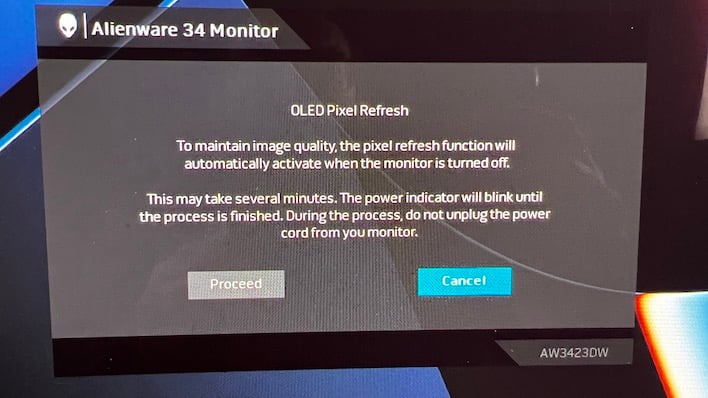
What's more is that on multiple occasions, particularly in games that have a lot of static elements, the monitor prompted us to let us know that it was going to run the pixel refresh while we were using it. We had to navigate to Cancel using the joystick in order to dismiss the prompt, which sits right in the middle of the screen, while we were in the middle of a game. After that happened three or four times, we notified Alienware, who let us know that they'd seen something similar during internal testing and thought it might be a firmware bug. So there might be a new firmware for the AW3423DW that is a little less aggressive about self-care and might let us test for image retention, but right now it's just not possible on our unit.
The good news is that Alienware gives the AW3423DW a three-year warranty, which not only covers component failures but burn-in as well. The company seems to think that it's perfectly safe to use normally. In that case, that's likely what we'd do, and just look for retention issues over time. That's what the warranty is for, so we wouldn't lose any sleep over it.

